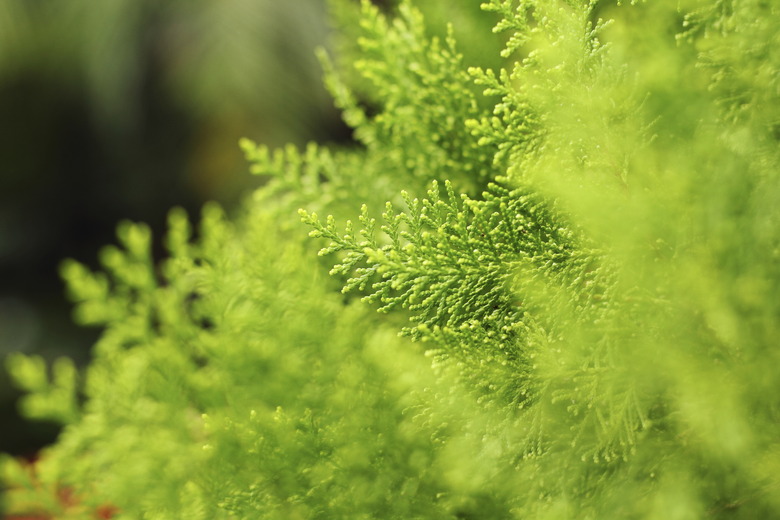Types Of Arborvitae Shrubs
Don't try eeny, meeny, miney, moe when it comes to picking arborvitae shrubs for your garden, or you may end up with a wall of dense, green foliage blocking your ocean view. These conifers in the cypress family come in sizes ranging from dwarf to giant. All offer gorgeous needles in delicate snowflake patterns. Most gardeners line up arborvitae in hedges like obedient soldiers, but they look great as stand-alone specimens too. In either case, height remains a critical factor.
Step 1
Ho-ho-ho. Perhaps the most famous arborvitae type is the Green Giant (Thuja standishii x plicata), which grows in U.S. Department of Agriculture plant hardiness zones 5 through 7. Produced by the U.S. National Arboretum, the Green Giant grows quickly and without major pest or disease problems to the imposing height of 30 feet, spreading to some 20 feet. Other varieties are even taller: It's a stretch to call Pyramidal arborvitae (Thuja occidentalis "Pyramidalis") a shrub, when it shoots up to some 60 feet tall and 15 feet wide in zones 3 through 8. Both of these arborvitae grow faster than seems possible.
Step 2
Not Quite So Tall
Step 1
If you want an imposing hedge plant for zones 2 to 7 but you are not thinking of something taller than the house, consider Emerald arborvitae (Thuja occidentalis "Emerald"), also called American arborvitae. Emerald rises to 10 feet, but not quite at the pace of a speeding bullet. It bulks out to only about 3 to 6 feet. If you can't find Emerald, Techny (Thuja occidentalis "Techny") is an excellent alternative that reaches 15 feet tall. It also grows relatively slowly, but it ends up more of a pyramid, with an 8-foot base at maturity. Techny thrives in zones 3 through 8.
Step 2
- Perhaps the most famous arborvitae type is the Green Giant (Thuja standishii x plicata), which grows in U.S. Department of Agriculture plant hardiness zones 5 through 7.
- Other varieties are even taller: It's a stretch to call Pyramidal arborvitae (Thuja occidentalis "Pyramidalis") a shrub, when it shoots up to some 60 feet tall and 15 feet wide in zones 3 through 8.
Less Tall
Step 1
Gardeners who want to stand nearly eye-to-eye with their arborvitae can opt for medium-to-small shrubs like Woodward globe (Thuja occidentalis "Woodwardii"), or Rheingold (Thuja occidentalis "Rheingold"), depending on the shape desired. Woodward globe, as the name suggests, grows into a fat sphere of an evergreen that gets 4 to 10 feet tall and 8 to 15 feet wide in zones 3 through 7. Rheingold arborvitae offers gold-tinged foliage and a slightly more conical shape, growing some 5 feet tall and 3 to 5 feet wide in zones 4 through 8.
Downright Short
Step 1
If you choose a plant called Mr. Bowling Ball (Thuja occidentalis "Bobozam"), you can't expect to put a hammock in it. Mr. Bowling Ball is round and small, between 2 and 3 feet in both directions. With deep green, dense foliage, Mr. Bowling Ball thrives in zones 3 through 8. Nor is Teddy arborvitae (Thuja occidentalis "Teddy") likely to inspire awe, but it sure is cute with its dwarfed size and finely textured foliage. It only gets about 1 foot high and 2 feet wide in zones 3 through 8.
Step 2
- Gardeners who want to stand nearly eye-to-eye with their arborvitae can opt for medium-to-small shrubs like Woodward globe (Thuja occidentalis "Woodwardii"), or Rheingold (Thuja occidentalis "Rheingold"), depending on the shape desired.
- Woodward globe, as the name suggests, grows into a fat sphere of an evergreen that gets 4 to 10 feet tall and 8 to 15 feet wide in zones 3 through 7.
